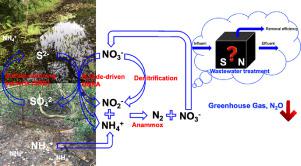Water Research ( IF 11.4 ) Pub Date : 2020-11-07 , DOI: 10.1016/j.watres.2020.116619 Qingkun Wang , Matthew James Rogers , Sir Sing Ng , Jianzhong He

|
Wetland ecosystems play an important role in nitrogen cycling, yet the role of anaerobic ammonium oxidation (anammox) in tropical wetlands remains unclear. In the current study the anammox process accounted for 29.8 ~ 57.3% of nitrogen loss in ex situ activity batch tests of microcosms established from anoxic sediments of different tropical wetlands, with the highest activity being 17.95±0.51 nmol-N/g dry sediment/h. This activity was most likely driven by sulfide oxidation with dissimilatory nitrate reduction to ammonium (sulfide-driven DNRA). Microbial community analyses revealed a variety of anammox bacteria related to several known lineages, including Candidatus Anammoximicrobium, Candidatus Brocadia and Candidatus Kuenenia, at different wetlands. Metagenome predictions, batch tests, and isotope-tracing suggested that the high level of anammox activity was due to sulfide-driven DNRA. This was corroborated by a strong correlation (through Pearson's analysis) between the abundance of anammox bacteria and the nrfA (a dissimilatory nitrate reduction to ammonium gene) and dsrA (a sulfate reductase gene) genes, as well as sulfate, ammonium and nitrate concentrations. These correlations suggest syntrophic interactions among sulfate-reducing, sulfide-driven DNRA, and anammox bacterial populations. A better understanding of the role of sulfur in nitrogen loss via the anammox reaction in natural systems could inform development of a viable wastewater treatment strategy that utilizes sulfate to minimize the activity of denitrifying bacteria and thus to reduce nitrous oxide emissions from wastewater treatment plants.
中文翻译:

固定的脱氮机制与热带湿地中的硫循环相关
湿地生态系统在氮循环中起着重要作用,但是在热带湿地中厌氧铵氧化(anammox)的作用仍不清楚。在目前的研究厌氧氨氧化过程中占氮损失的29.8〜57.3%易地从不同热带湿地的缺氧沉积物建立微观的活动批量试验,具有最高活性为17.95±0.51纳摩尔-N / g干沉积物/ h的。这种活性很可能是由硫化物氧化和硝酸盐异化还原成铵(硫化物驱动的DNRA)驱动的。微生物群落的分析揭示了多种相关的几个已知的谱系,包括厌氧氨氧化菌的暂定Anammoximicrobium,暂定Brocadia和暂定Kuenenia,在不同的湿地。元基因组的预测,批处理测试和同位素示踪表明,高的厌氧氨氧化活性是由于硫化物驱动的DNRA。这是由丰度厌氧氨氧化菌的和之间的强相关性(通过Pearson的分析)证实nrfA(一个异化硝酸还原到基因铵)和dsrA(硫酸盐还原酶基因)基因,以及硫酸盐,铵盐和硝酸盐的浓度。这些相关性表明减少硫酸盐的,硫化物驱动的DNRA和厌氧氨氧化细菌种群之间的同养相互作用。更好地了解硫在自然系统中通过厌氧氨氧化反应在氮损失中的作用,可能有助于开发可行的废水处理策略,该策略利用硫酸盐使反硝化细菌的活性降至最低,从而减少废水处理厂的一氧化二氮排放。











































 京公网安备 11010802027423号
京公网安备 11010802027423号